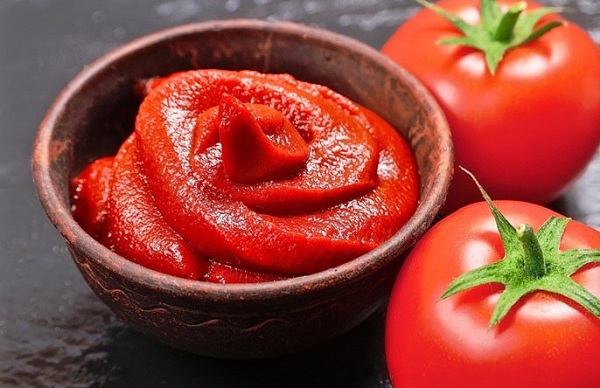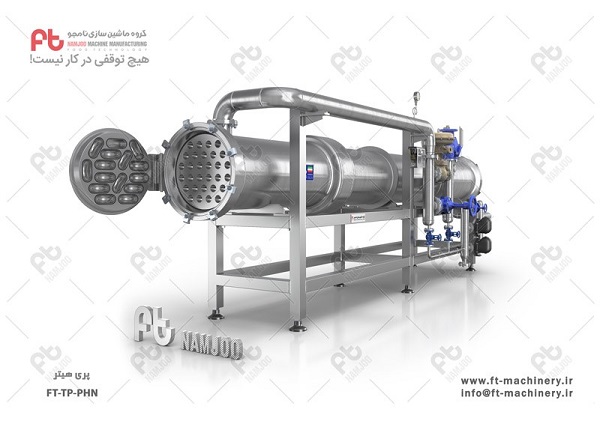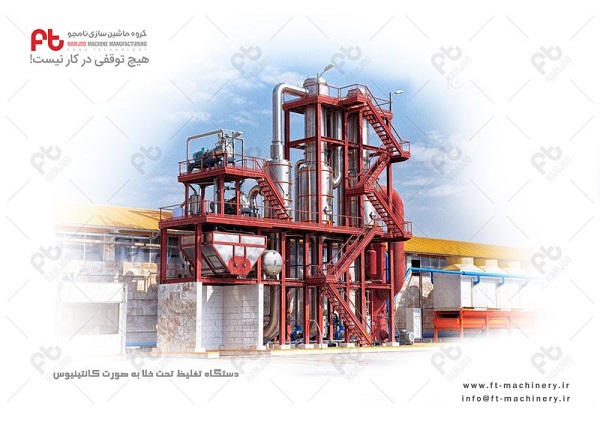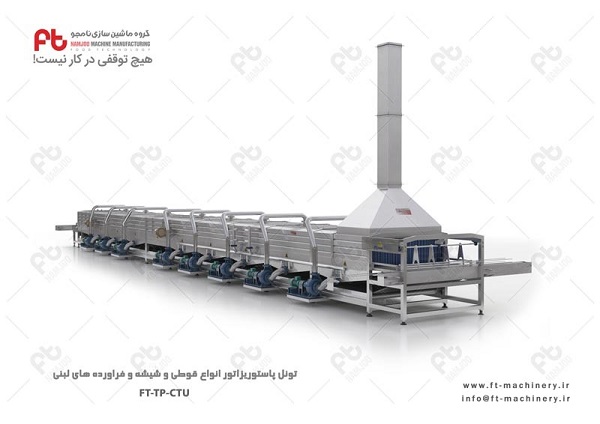In this article, you will get acquainted with the production steps of tomato paste as well as the machines used in the tomato paste production line. We will also have a brief overview of the different types of tomato paste packaging.
Tomato paste is one of the most widely used foods in cooking, which is used in the preparation of various foods that in the past, people prepared it in the traditional way at home. Gradually, with the advancement of technology and industry and the increasing expansion of urbanization and industrial life, the production of home-made food has also given way to products produced by food industries and factories.
Annually, a large amount of tomatoes produced in the agricultural sector are sent to tomato paste factories to be processed. For this purpose, various processes are performed on the product in the production line of tomato paste of factories so that tomato paste, which is a product with high durability and suitable for families, is produced and sent to the market.

Familiarity with the different stages of the tomato paste production line
We examine the different stages of production of this product in the factory separately. The production line of tomato paste from the beginning of the import of raw materials to the production and packaging of the final product includes various stages, each of which is of special importance in the quality of the final product as well as the profitability and efficiency of the factory.
In the following, we will describe the processes and introduce the devices and machines used in the tomato paste production line, and we hope that by reading these explanations, you will gain a complete and useful knowledge about the tomato paste production process. .
The production steps of tomato paste in the factory are as follows:
- Get tomatoes
- Washing and sorting
- Chop the tomatoes
Preheat and kill enzymes
- Strain the tomato juice
Concentrate tomato paste
- Product filling and capping
- Baking and pasteurizing the product

1- Receiving tomatoes
The first thing that is done in a tomato paste factory is sampling, receiving and weighing the consignments of tomatoes harvested from agricultural lands. At the entrance of the factory, samples of cargo containing tomatoes are sampled and if their quality is confirmed, the tomatoes are ready to enter the paste production line.
At this stage, the tomatoes are drained in large pools of water and transferred to the next stages, ie washing and sorting, with the flow of water and with the least damage.
2- Sorting tomatoes by sorting machine
Sorting is one of the first and most important operations performed in food factories on the received raw materials. Sorting is done in factories for different purposes. Sometimes the purpose of sorting is to separate and classify raw materials into different categories. But sorting is done in the tomato paste production line, in order to separate unsuitable tomatoes and other unwanted materials from quality tomatoes.
3- Crushing tomatoes with a crusher
The cleaned and sorted tomatoes, after passing through the sorting machine, enter the crusher and are crushed by its movable blades. There are different types of shredders, but for tomatoes, the comb or disc type is used. The shredded tomatoes by the crusher are ready to enter the next stage of the tomato paste production line, ie preheating and enzyme removal.
4- Heating and enzymatizing chopped tomatoes with a preheater
After chopping the tomatoes, they enter a device called a preheater. The pre-heater prepares the processed process by applying heat to the chopped tomatoes to enter the strainer and dehydration operation. The process temperature in the preheater can be from about 60 to 85 degrees Celsius. This heating, by disintegrating and softening the tomato texture, increases the yield efficiency of the product in the filtration stage and also inactivates the pectinase enzyme in tomatoes, which results in the production of tomato paste in the later stages of production. It will have good viscosity and consistency. The high temperature of this stage of the production line also reduces the possible microbial load in the product and contributes to the healing process in the next stages.
The preheating process by the preheater is an important and sensitive step in the production line of tomato paste, which has a great impact on the quality of the final product as well as the dehydration efficiency of the product, and having full and continuous accuracy and monitoring is important. Is a lot.

5 – Strain tomato juice by strainer
After passing through the preheater, the chopped tomatoes enter the tomato juice filter. The filtering machine separates the skin and seeds from the tomato juice in the tomato paste production line. Smoothing machines are used in one or more stages, so that the difference between different stages is in the diameter of its nets. The mesh of the first stage filter machine is a hole with a diameter of one millimeter and the mesh of the second stage filter machine is about 0.7 mm.
Depending on the conditions of the raw materials, the smoothing operation can be done in one step or in several stages. Multi-stage smoothing operation increases the efficiency of dewatering operations and increases the quality of the product. Tomato juice obtained from the strainer enters its special storage tank. This storage tank causes balance and continuous flow of the product in the tomato paste production line so that the devices and machines of the production line can continue to work continuously and without stopping.
6- Concentration of tomato paste by Batch or Continuus machine under vacuum
The filtered tomato juice is pumped to the concentrator. Concentration process in the tomato paste production line, depending on the production volume and the desired concentration of the final product, may be done using a batch concentrator or a Continuus paste machine. Batch concentrator is used for lower production volume and has the ability to concentrate tomato paste to higher concentrations, but Continues concentrator is used for higher production volume and has less concentration ability compared to batch machine.
On the other hand, the main similarity between Batch and Continuus paste condensers is concentrating under vacuum conditions, which is the main reason for the good taste and color and high nutritional value of industrially produced tomato paste. Concentrate the tomato juice in a vacuum concentrator using steam heat in one or more steps to reach the desired concentration. Tomato paste obtained from the concentrator enters the paste storage tank to be used for final packaging.

7- Filling and capping tomato paste
Tomato paste with suitable concentration, after adding a certain amount of salt to it, is ready for packaging and is sent to the filling machine in the tomato paste production line. The important point in the process of filling canned products such as tomato paste is filling the product hot in the packaging container,
which causes the proper quality of the pasteurization process in the final stage of production.
Tomato paste is heated to a temperature of about 80 to 90 degrees Celsius by a special heat exchanger called a tube pasteurizer, which is placed in the production line before the filling machine. Hot tomato paste may be packed in special metal cans or glass-like containers.
The filled cans are then sealed and sealed in an impenetrable manner. Proper and impenetrable capping guarantees the shelf life of the product in the long run, and for this reason, capping operations in the production line of tomato paste and other canned products are always considered as a sensitive and key operation.
8- Pasteurization of tomato paste by cooking tunnel
Tomato paste packed in metal cans or glass containers enters a special device called a pasteurization tunnel to apply the pasteurization process. In this machine, which is also known in the industry as a cooking tunnel, the product is packed using boiling water for a certain period of time,
under a heat process of about 90 degrees Celsius. After the filling and capping operation, the thermal pasteurization process is also a sensitive and key operation in the tomato paste production line, which guarantees the long shelf life of the commercial product.
All canned products need their own thermal processing to have a long shelf life.
Of course, according to the nature of the product, in food factories, one of the types of thermal processes of pasteurization or sterilization is performed on products. It is noteworthy that in the pasteurization process,
compared to the sterilization process, less temperature and time are used to heat the products.
After heating and completing the heating process, the products should be cooled and . cooled to ambient temperature so that no moisture remains on the product containers (glass or metal cans). In the past, the process of pasteurizing canned tomato paste was done by vertical boiling water boilers,
and then the products were cooled in cold water pools or by cold showers and dried with poor quality, but using a tunnel cooking machine, all three The operation of heating, cooling and drying the product containers is done together.

Types of tomato paste packaging
Paste factories produce their products in different packages according to their customers and markets, and for this purpose,
different machines and equipment may be used in the tomato paste production line.
If the factory aims to produce the product for families and end consumers .
the tomato paste will be packaged in small packages suitable for household consumption, such as metal cans or small glass containers of 400 g or 800 g, and will be offered to the general consumer market.
Be.
Sometimes tomato paste may be packaged in containers weighing 5 kg or more for customers such as kitchens and restaurants who consume more than families. However, due to the fact that tomatoes are a seasonal product and are harvested only in a few months of the year .
all tomato paste production and processing factories produce tomato paste in bulk at the time of peak harvest and receipt of tomatoes.
They are packed and stored in special 200 kg plastic and metal barrels.
In addition to storage in metal and plastic barrels, in some factories .
tomato paste is packaged in 200 kg packages called aseptic using special equipment and machines. Aseptic tomato paste has a long shelf life and is mainly used for export markets.
